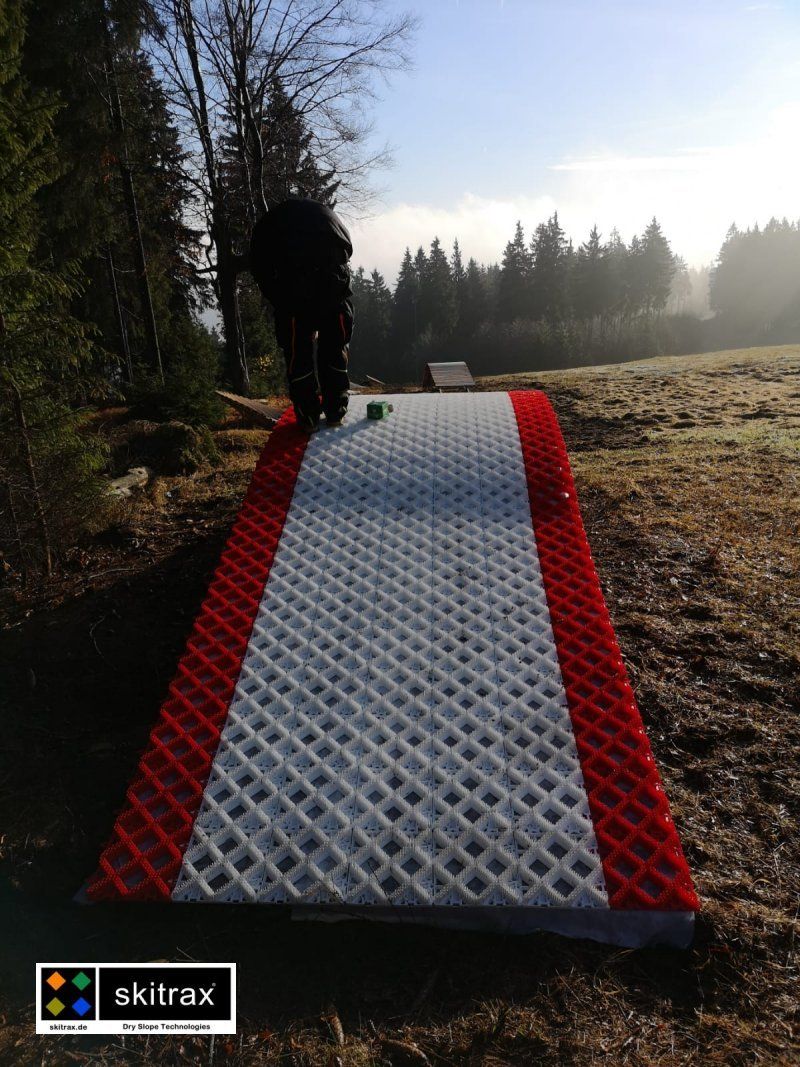Snow of tomorrow is already here
The alternative to the lost snow
When we built the freestyle water jump in Oberaudorf 15 years ago, we were one of the pioneers in Germany in the field of "using plastic mats for skiing". Freestylers were thrilled to finally be able to safely practice their first simple to extreme jumps on trampolines and water jumps in the summer. To date, we have been allowed to supply our mats to over twenty o their jumps on four continents. These include the largest freestyle mega jumps in the world. It has been confirmed that especially the training for young skiers on such jumps can be introduced to the extreme conditions in winter on snow. It works and the new school winter sports are expanding successfully.
Alpine skiing is now facing a much bigger problem - less and less snow is falling and the belief in miracles is fading. For ordinary skiers, the situation arises to book early vacations at higher ski resorts - with rising alternative costs. The regions around the (still) glacier ski areas are pleased with the increase. Less pleased are the approximately 4,000 ski clubs and tens of thousands of ski schools in the central Alps. Where will the new generation come from if there is no longer enough snow - or better, at the right time, when training is needed? With high inflation and falling average household incomes (at least in Germany), members of the many ski clubs can no longer afford expensive trips to the glaciers for technical training.
The ski associations and ski clubs have been complaining about the lack of young talent for years. A change on the spot can help, where most people are at home, where the journey to the training track is not far and where training can also be done quickly for 2 hours after school. Climate change is a fact and we have to learn to deal with it. It is right to set climate targets, only the ways to achieve them vary in intensity. Only those who seek new ways will find innovative solutions. As recently as the 1980s, there was at least 5 meters of consolidated snow in winter in the ski resorts of the Central Alps at about 1500 meters above sea level. In many hotels, the only way to get to the hotel was via the second floor.
Now it will be too warm in many ski resorts to snow the slopes in winter. And then? Yesterday's snow in the Alps for most of the 2022/2023 season won't come until mid-January 2023. Fewer snow-covered ski areas mean less tourism and lower to no revenue in running costs. To squeeze costs, dozens of ski areas at elevations below 900 m have already not even started the season!
Is there an alternative snow? Is artificial snow out and synthetic snow in?
The trick is to make snow without using cannons. Significantly more than half of the CO2 emissions from skiing are caused by the increasingly long journey by car, especially to higher alpine ski resorts and their glacier areas. For this reason, it is desirable that smaller ski resorts continue to exist and offer ski safety. Whether you are a beginner or an advanced skier, only those who know they can ski will go to a ski resort.
Ski resorts that are located above 1500 meters and can be reached with snappy gondolas and speed chairlifts do not yet need to worry about snow safety. However, these areas also have a valley station that is the mecca for beginners and children's ski schools - in other words, the future of alpine winter sports. What would be the impact of no skiing in the future?
In Oberaudorf (Germany), the first mat ski slope was built in Kinderland to enable the local ski school to hold ski courses at all. The Kinderskiland at Adventure Mountain Ski Resort Hocheck is only about 600 meters above sea level and is actually a snow hole. The water supply is assured and the 40 snow cannons normally provide complete snow coverage for the entire ski area within a week for the pre-Christmas season. However, due to high temperatures, no operations could be carried out until the end of January. The managing director of the mountain railroad, Hannes Rechenauer, has noticed a noticeable decline in young skiers, especially among schoolchildren who come to Oberaudorf from the big city of Munich by regional train. Twenty years ago, about half of a class could ski. "Now, with 30 kids, there are maybe seven or eight left." Without guaranteed snow, there's no ski camp. "Then the teachers say they'd rather go to the zoo."
In any case, with the dry ski slope, Rechenauer now has more traffic than he himself had expected. "I'm surprised how well people have taken to it," he says. "Kids and beginners see it as a good alternative." In the upper area at an altitude of about 850m, the approx. 300m-long surface lift is to be put into operation as early as the beginning of October. A dry ski slope about 10m wide is to ensure that more than 100 ski clubs in the area can carry out technical training with slalom and giant slalom for the youth. It is also intended to reduce expensive car trips with long journeys and high CO2 emissions to the glacier ski areas. A similar project will be realized by Sporthotel Elldus in Oberwiesenthal (GER) in spring 2023: a dry slope ski slope for ski courses and tubing tracks in the same place with a conveyor belt for summer and winter operation.
By the way, more and more recreational athletes have been buying Slopetrax mats in smaller quantities for years to build a rail in their own backyard. They would very much like to ride on larger facilities all year round - but unfortunately these are not (yet) offered!
Whether alpine skier or snowboarder, on the Skitrax mat ski slopes can be skied at any time: Goal bar training, shred over obstacles, jump into the airbag with jumps or complete precise technique training. Fun kids and ski schools for beginners are also possible - all without snow, in warm weather and without the stress of getting there, but with a lot of fun.
The "snow of tomorrow" is already here. The new generation is also there and is waiting for a rethink from the ski associations, tourism companies and city planners in the big cities, as this is where the majority of skiers and snowboarders live and are waiting for change.
UPDATE - Berichte von anderen Installationen






























